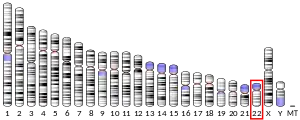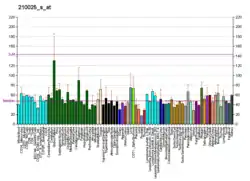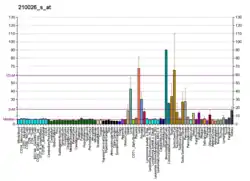CARD10
Caspase recruitment domain-containing protein 10 is a protein in the CARD-CC protein family that in humans is encoded by the CARD10 gene.[5][6][7]
Function
The caspase recruitment domain (CARD) is a protein module that consists of 6 or 7 antiparallel alpha helices. It participates in apoptosis signaling through highly specific protein-protein homophilic interactions. CARDs induce nuclear factor kappa-B (NF-κB; MIM 164011) activity through the IKK (e.g., IKBKB; MIM 603258) complex. CARD9 (MIM 607212), CARD10, CARD11 (MIM 607210), and CARD14 (MIM 607211) interact with BCL10 (MIM 603517) and are involved in NF-κB signaling complexes. Except for CARD9, these CARD proteins are members of the membrane-associated guanylate kinase (MAGUK) family.[supplied by OMIM][7]
References
- GRCh38: Ensembl release 89: ENSG00000100065 - Ensembl, May 2017
- GRCm38: Ensembl release 89: ENSMUSG00000033170 - Ensembl, May 2017
- "Human PubMed Reference:". National Center for Biotechnology Information, U.S. National Library of Medicine.
- "Mouse PubMed Reference:". National Center for Biotechnology Information, U.S. National Library of Medicine.
- Wang L, Guo Y, Huang WJ, Ke X, Poyet JL, Manji GA, Merriam S, Glucksmann MA, DiStefano PS, Alnemri ES, Bertin J (June 2001). "Card10 is a novel caspase recruitment domain/membrane-associated guanylate kinase family member that interacts with BCL10 and activates NF-kappa B". J. Biol. Chem. 276 (24): 21405–9. doi:10.1074/jbc.M102488200. PMID 11259443.
- Gaide O, Martinon F, Micheau O, Bonnet D, Thome M, Tschopp J (May 2001). "Carma1, a CARD-containing binding partner of Bcl10, induces Bcl10 phosphorylation and NF-kappaB activation". FEBS Lett. 496 (2–3): 121–7. doi:10.1016/S0014-5793(01)02414-0. PMID 11356195.
- "Entrez Gene: CARD10 caspase recruitment domain family, member 10".
- Wang L, Guo Y, Huang WJ, Ke X, Poyet JL, Manji GA, Merriam S, Glucksmann MA, DiStefano PS, Alnemri ES, Bertin J (June 2001). "Card10 is a novel caspase recruitment domain/membrane-associated guanylate kinase family member that interacts with BCL10 and activates NF-kappa B". J. Biol. Chem. 276 (24): 21405–9. doi:10.1074/jbc.M102488200. PMID 11259443.
External links
- Human CARD10 genome location and CARD10 gene details page in the UCSC Genome Browser.
Further reading
- Dunham I, Shimizu N, Roe BA, Chissoe S, Hunt AR, Collins JE, Bruskiewich R, Beare DM, Clamp M, Smink LJ, Ainscough R, Almeida JP, Babbage A, Bagguley C, Bailey J, Barlow K, Bates KN, Beasley O, Bird CP, Blakey S, Bridgeman AM, Buck D, Burgess J, Burrill WD, O'Brien KP (1999). "The DNA sequence of human chromosome 22". Nature. 402 (6761): 489–95. doi:10.1038/990031. PMID 10591208.
- McAllister-Lucas LM, Inohara N, Lucas PC, Ruland J, Benito A, Li Q, Chen S, Chen FF, Yamaoka S, Verma IM, Mak TW, Núñez G (2001). "Bimp1, a MAGUK family member linking protein kinase C activation to Bcl10-mediated NF-kappaB induction". J. Biol. Chem. 276 (33): 30589–97. doi:10.1074/jbc.M103824200. PMID 11387339.
- Sun L, Deng L, Ea CK, Xia ZP, Chen ZJ (2004). "The TRAF6 ubiquitin ligase and TAK1 kinase mediate IKK activation by BCL10 and MALT1 in T lymphocytes". Mol. Cell. 14 (3): 289–301. doi:10.1016/S1097-2765(04)00236-9. PMID 15125833.
- Stilo R, Liguoro D, Di Jeso B, Formisano S, Consiglio E, Leonardi A, Vito P (2004). "Physical and functional interaction of CARMA1 and CARMA3 with Ikappa kinase gamma-NFkappaB essential modulator". J. Biol. Chem. 279 (33): 34323–31. doi:10.1074/jbc.M402244200. PMID 15184390.
- McAllister-Lucas LM, Ruland J, Siu K, Jin X, Gu S, Kim DS, Kuffa P, Kohrt D, Mak TW, Nuñez G, Lucas PC (2007). "CARMA3/Bcl10/MALT1-dependent NF-kappaB activation mediates angiotensin II-responsive inflammatory signaling in nonimmune cells". Proc. Natl. Acad. Sci. U.S.A. 104 (1): 139–44. doi:10.1073/pnas.0601947103. PMC 1766317. PMID 17101977.





